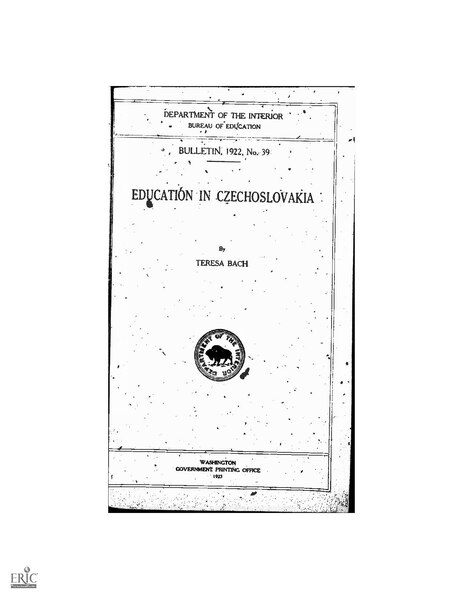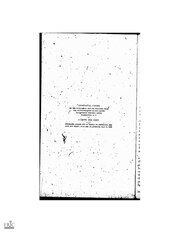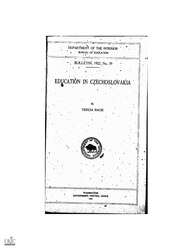File:ERIC ED540381. Education in Czechoslovakia. Bulletin, 1922, No. 39.pdf

Original file (1,275 × 1,650 pixels, file size: 2.46 MB, MIME type: application/pdf, 28 pages)
Captions
Captions
Summary[edit]
| ERIC ED540381: Education in Czechoslovakia. Bulletin, 1922, No. 39
|
||
|---|---|---|
| Author |
ERIC |
|
| Title |
ERIC ED540381: Education in Czechoslovakia. Bulletin, 1922, No. 39 |
|
| Description |
The Czecho-Slovak Republic, proclaimed independent October 28, 1918, comprises an area of 54,000 square miles. It is inhabited by Czechs and Slovaks, two branches of the western Slavs, from whom the Republic derived its name. The new State reunites the Provinces of Bohemia, Moravia, Silesia, and Slovakia, and the autonomous territory of Carpathian Russia. Barely four years have elapsed since its independence was proclaimed, yet the process of economic and political reconstruction has advanced perceptibly. The aim of the present Government in matters of education, like those of State, is to coordinate the two diverse arrangements that hitherto separated Bohemia from Slovakia. Education is compulsory for all the children in the State. In the Czech-speaking Provinces, education is widespread and illiteracy low, while, in Slovakia, it is much higher. In the former Provinces the compulsory age for children extends over 8 years (from the age of 6 to 14), with the exception of rural districts, where children may be excused from attendance after the age of 12. In Slovakia and Carpathian Russia, the compulsory age is from 6 to 12, i.e., 6 years only. Continuation classes are established in some places for those between 12 and 15, but as attendance in these schools is not enforced, their influence is negligible. In general, the school attendance in Slovakia and Subcarpathian Russia is unsatisfactory, especially in the mountains regions, where school work encounters many difficulties. These shortcomings are realized by the new authorities, and no effort is spared in opening new schools and thus raising the standard of education in this part of the country. The question of lengthening the period of attendance receives serious consideration, and it is quite likely that in the near future a uniform eight-year compulsory school period will be the minimum requirement throughout the Republic. Topics covered in this bulletin include: (1) Kindergarten and nursery schools; (2) Elementary education; (3) Recent changes in education; (4) The budget of the Ministry of Education for the year 1922; (5) Administration; (6) Minority schools; (7) Teacher training; (8) Teachers' organizations; (9) Secondary education; (10) Agricultural education; (11) Home economics schools; (12) Industrial education; (13) Commercial education; and (14) Higher education. (Contains 6 footnotes.) [Best copy available has been provided.] |
|
| Language | English | |
| Publication date |
1923 publication_date QS:P577,+1923-00-00T00:00:00Z/9 |
|
| Source | Internet Archive identifier: ERIC_ED540381 | |
This file is in PDF format.
Portable Document Format (PDF) is a file format created by Adobe Systems for document exchange. PDF is used for representing two-dimensional documents in a manner independent of the application software, hardware, and operating system. Each PDF file encapsulates a complete description of a fixed-layout 2D document that includes the text, fonts, images, and 2D vector graphics which compose the documents. The best way to view PDF files is locally using a reader.Several free readers for every system are available at pdfreaders.org. Deutsch | English | español | français | македонски | Nederlands | português | русский | +/−
|
Licensing[edit]
This image is in the public domain because it is a mere mechanical scan or photocopy of a public domain original, or – from the available evidence – is so similar to such a scan or photocopy that no copyright protection can be expected to arise. The original itself is in the public domain for the following reason:
This tag is designed for use where there may be a need to assert that any enhancements (eg brightness, contrast, colour-matching, sharpening) are in themselves insufficiently creative to generate a new copyright. It can be used where it is unknown whether any enhancements have been made, as well as when the enhancements are clear but insufficient. For known raw unenhanced scans you can use an appropriate {{PD-old}} tag instead. For usage, see Commons:When to use the PD-scan tag. | |||||
| Public domainPublic domainfalsefalse |
| This image is a work of a United States Department of Education employee, taken or made as part of that person's official duties. As a work of the U.S. federal government, the image is in the public domain in the United States. |  |
File history
Click on a date/time to view the file as it appeared at that time.
| Date/Time | Thumbnail | Dimensions | User | Comment | |
|---|---|---|---|---|---|
| current | 22:32, 5 July 2023 |  | 1,275 × 1,650, 28 pages (2.46 MB) | Wocabe3470 (talk | contribs) | Importation from Internet Archive via IA-upload |
You cannot overwrite this file.
File usage on Commons
The following 2 pages use this file:
Metadata
This file contains additional information such as Exif metadata which may have been added by the digital camera, scanner, or software program used to create or digitize it. If the file has been modified from its original state, some details such as the timestamp may not fully reflect those of the original file. The timestamp is only as accurate as the clock in the camera, and it may be completely wrong.
| Date and time of digitizing | 23:11, 19 September 2011 |
|---|---|
| Software used | PdfCompressor 5.0.333 |
| File change date and time | 08:53, 5 March 2013 |
| Date metadata was last modified | 08:53, 5 March 2013 |
| Conversion program | CVISION Technologies |
| Encrypted | no |
| Page size | 612 x 792 pts (letter) |
| Version of PDF format | 1.6 |


